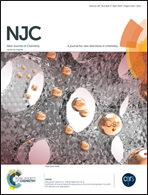Host–guest interaction of coumarin-derivative dyes and cucurbit[7]uril: leading to the formation of supramolecular ternary complexes with mercuric ions†
Abstract
We investigated the photophysical behavior of the complexes formed between cucurbit[7]uril (CB7) and coumarin-derivative dyes: 7-(diethylamino)-N-(1,3-dihydroxy-2-(hydroxymethyl)propan-2-yl)-2-oxo-2H-chromene-3-carboxamide (1) and N-(1,3-dihydroxy-2-(hydroxymethyl)propan-2-yl)-11-oxo-2,3,5,6,7,11-hexahydro-1H-pyrano[2,3-f]pyrido[3,2,1-ij]quinoline-10-carboxamide (2), in the absence or presence of mercuric ions (Hg2+). The maximum absorption of 1 shows a bathochromic shift with the addition of CB7 and the fluorescence intensity is highly increased. In contrast, addition of CB7 has no noticeable effect on the spectroscopic properties of 2. However, fluorescence quenching was observed in both cases after the addition of Hg2+. Interestingly, in the absence of it fluorescence lifetime measurements for the 1–CB7 complex suggest that the macrocycle is able to prevent the aggregation of 1. The stoichiometry for these complexes, determined from the fluorescence titration measurements and mass spectrometry, indicates that 1 : 1 complexes are formed and the binding constants (Kb) are estimated to be around 105 M−1. The NMR studies indicate that both dyes are included in the CB7 cavity but different moieties interact with it. Considering the hydrophobic effect of the cavity, and metal–ligand and ion–dipole interactions, it can be concluded that both compounds are able to form a novel supramolecular assembly that comprises CB7, 1 or 2 and Hg2+. The binding observed between them displays a positive cooperative effect relative to the dyes alone, 1–CB7 being the most efficient complex (Kb ≈ 107 M−1) in acidic conditions. Thus, the potential for these types of complexes to be used as multifaceted functional systems appears warranted.
![Graphical abstract: Host–guest interaction of coumarin-derivative dyes and cucurbit[7]uril: leading to the formation of supramolecular ternary complexes with mercuric ions](/en/Image/Get?imageInfo.ImageType=GA&imageInfo.ImageIdentifier.ManuscriptID=C5NJ00162E&imageInfo.ImageIdentifier.Year=2015)

 Please wait while we load your content...
Please wait while we load your content...